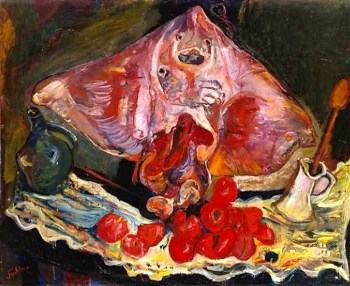Caught on a Facebook site that posts reproductions of artworks, Chaïm Soutine’s Still Life with Rayfish (ca. 1924):
The accompanying note:
In this unsettling adaptation of Jean-Siméon Chardin’s The Rayfish (ca. 1725–26), Soutine paired the fish’s bloody entrails with a smiling, almost humanlike mouth. He reanimated the dead ray by concentrating on its vibrant underbelly and used thick, fluid brushstrokes to suggest slick flesh.
Background 1: rays. From Wikipedia:
Batoidea is a superorder of cartilaginous fishes commonly known as rays. They and their close relatives, the sharks, comprise the subclass Elasmobranchii. Rays are the largest group of cartilaginous fishes, with well over 600 species in 26 families. Rays are distinguished by their flattened bodies, enlarged pectoral fins that are fused to the head, and gill slits that are placed on their ventral surfaces.
Rays are totally fascinating to watch in motion, but very hard to capture in still photos. Here’s a nice image from the Minnesota Zoo site of a Southern stingray in the water:
Background 2: Soutine. From Wikipedia:
Chaïm Soutine (13 January 1893 – 9 August 1943) was a Russian painter who made a major contribution to the expressionist movement while living and working in Paris.
Inspired by classic painting in the European tradition, exemplified by the works of Rembrandt, Chardin and Courbet, Soutine developed an individual style more concerned with shape, color, and texture over representation, which served as a bridge between more traditional approaches and the developing form of Abstract Expressionism.
Background 3: Chardin. From Wikipedia:
Jean-Baptiste-Siméon Chardin (November 2, 1699 – December 6, 1779) was an 18th-century French painter. He is considered a master of still life, and is also noted for his genre paintings which depict kitchen maids, children, and domestic activities. Carefully balanced composition, soft diffusion of light, and granular impasto characterize his work
… Upon presentation of The Ray and The Buffet in 1728, he was admitted to the Académie Royale de Peinture et de Sculpture.
Chardin’s The Ray.
From Wikipedia on the painting (also rather unsettling):
The Ray (French: La raie) is a still life painting by Jean Simeon Chardin, first exhibited at the Exposition de la Jeunesse on 3 June 1728, and long held by the Louvre in Paris.
… Chardin depicts the bloody underside of a skate, gutted and hanging from a hook on the stone wall. The fish lies above a shelf on which there are various domestic items to the right on a white cloth: two metal pans, a ceramic jug and a bottle, and a knife. Below the skate are two other fish, and further to the left are some opened oysters and a cat with an arched back and raised fur, as if frightened by the sight. The composition can be analysed as a series of pyramids, with the pointed skate in the centre, the jug and other inanimate objects to the right, and the cat and oysters to the left. The handle of the knife hanging off the ledge and the corner of the stone wall leading past the cat away from the viewer, add depth to the scene.
Lexicographic note: skates are a subtype of rays. From NOAD:
noun skate-2: a typically large marine fish of the ray family with a cartilaginous skeleton and a flattened diamond-shaped body. Family Rajidae: numerous species, in particular the commercially valuable Raja batis.
Addendum: Chardin’s The Buffet, presented to the Academy along with The Ray, is a more conventional still life, though complex (and it incorporates a dog):




October 21, 2020 at 8:41 am |
Chardin’s ray seems appropriate for Halloween and this election season, with the frowny mouth, spooky-ghost outline, and scaredy-cat